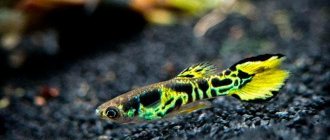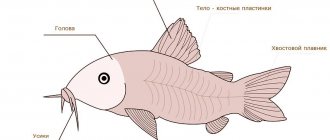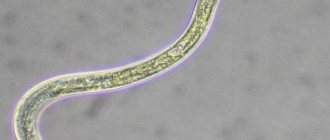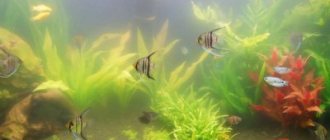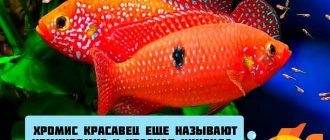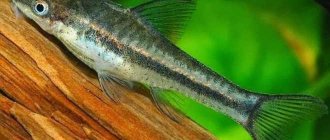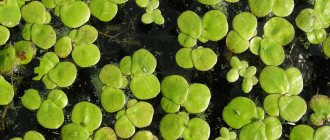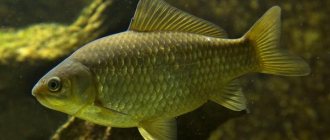DESCRIPTION, APPEARANCE, BUILDING
Neons are highly prized among aquarists. These fish are a real decoration for an aquarium. There are bright neon stripes on their body. Despite the bright colors, the fish do not distract, but, on the contrary, emphasize the beauty of the design created in the aquarium.
Neons are schooling fish and look great in an aquarium. Their bright shiny red or blue stripes along the body flash spectacularly in reflected light. This distinctive feature, which gives the fish a resemblance to neon signs, was the idea for their name.
The body of the fish is elongated and slightly flattened on the sides. On average, the length of neons is from 2.5 to 5 cm. The fish have a relatively small mouth, transparent fins, of which the anal one is longer than the dorsal one. Fishes of the order Characinidae are characterized by the presence of an adipose fin. It has no bony rays. The adipose fin is not paired and is located behind the dorsal fin.
It is noteworthy that in males the neon stripe is a straight line, while in females it has a slight break in the middle. Therefore, a specialist can easily distinguish a male from a female.
Most often in aquariums you can see red, blue and black neons.
black neon
red neon
blue neon
Feeding the young
The fry should be fed frequently, in small portions. Kids really like the mixture of zooplankton and rotifers. The diet of neon babies can be diversified by pureed boiled egg yolk and ciliates. Over time, small fish become accustomed to nauplii and cyclops.
When the neon chicks are two weeks old, the darkening begins to gradually be removed from the spawning area. At three weeks, the colorless fry acquire a characteristic neon shine. By the age of one month, small fish should be completely accustomed to normal lighting. By one and a half months, the water hardness should be brought to the usual level, new food should be introduced into the diet and the young animals should be transplanted into a regular aquarium.
Return to content
STORY
For the discovery of neons and their appearance in our aquariums, we should thank the French researcher Auguste Rabot. It was he who first discovered these fish in Peru, in the Putumayo River. The beauty of the fish literally bewitched Auguste. Being a very enterprising man with a touch of adventurism in his soul, he decided that he could make good money by exporting them.
In 1935, the first copies of neon were first delivered to Europe and the USA. Aquarists really immediately fell in love with these fish, they became very popular. The fact that neons did not require complex maintenance was an additional plus. Auguste Rabot received huge dividends from his find. The fact is that in artificial conditions problems arose with the breeding of neons. In the first years, no one simply succeeded, so Rabo became a monopolist in the supply of neon to Europe.
Some of the first copies were donated for advertising purposes to William Innesi, an aquarium enthusiast and popularizer. He, in turn, gave the fish to his friend, George Myers, who made the first scientific description of a new species - blue, or ordinary neon, which he named in honor of his friend.
For the first time, it was possible to obtain offspring under artificial conditions in Germany. This phenomenon was even called the “German miracle.” Over time, it became clear that the secret of this “miracle” was in the softness of the water that was used to contain neons. The information obtained served as an impetus for new research that discovered the mechanisms of influence on the successful reproduction of neons.
After spawning
After a couple of days, or more precisely, 36–38 hours, the juveniles hatch. Not all eggs survive. Some of the neon eggs may be affected by the fungus, or simply die during development. It is recommended to separate the fertilized eggs after 12 hours. This can be done using a pipette. Place the fertilized eggs in another container, as the risk of infection is very high.
An important factor is lighting. For neon fry, light is destructive. For several days after birth, they cannot see well. It is worth leaving one open corner where the light will flow.
The fry feed on ciliates, which accumulate just in the area of the light beam. Over time, the juveniles are fed Artemia nauplii and rotifers.
The water hardness is gradually increased by adding liquid from the general aquarium every day. After a month and a half, the juveniles begin to prepare for life with the rest of the fish.
HABITAT
The birthplace of neon is South America. In Peru, Colombia, and Brazil you can find these amazing fish in their natural habitat. The element of neon is calm waters. Therefore, they prefer slow-flowing tributaries of large rivers, the waters of which are rich in humic substances, to fast flows, which gives them a brown tint. The optimal conditions for the life and reproduction of neons are soft and acidic water. These are the conditions that are created in rivers flowing in the shadow of tropical forests. Decaying leaves, regular rains, and a large layer of silt make the water soft and acidic.
Neon habitat in nature
Preparing the spawning tank
In order for pets to reproduce, a nursery with suitable conditions for producing offspring is set up for neons. A 20 liter container is suitable for six fish; nylon mesh or Java moss is used as a substrate.
- hardness – up to 4 dH;
- acidity – up to 5 pH;
- temperature – 25–26C.
The water level in the fish tank should be at a distance of 15 cm from the edge of the spawning tank. To adapt, 200 ml of water from the previous aquarium where the fish previously lived is added to the aquarium.
Neons usually begin to reproduce on the same night when settlement occurred, or early in the morning, at dawn. The female lays eggs, and the male fertilizes them, after which the eggs fall onto the substrate. Immediately after breeding, the parents are moved back to preserve the long-awaited offspring. The hatchery with future fry is removed to a dark, secluded place.
CONDITIONS OF DETENTION
Neons are very popular aquarium fish. To make them feel comfortable, it is recommended to keep them in flocks of at least 5 individuals. When kept alone or in pairs, fish may lose tone and color, and their lifespan may also be noticeably shortened.
Schooling fish always stay in a group. Most often, neons swim chaotically and randomly, however, if they are frightened, the fish form a dense school and begin to swim almost synchronously.
The optimal water temperature in the aquarium for keeping them is +20...+26 °C, pH 6-7, total hardness is 6-15 °dH. Fish can live in water with higher hardness. Over the long history of breeding, they have adapted well to conditions different from their natural habitat.
The average lifespan of neons under artificial conditions is 3-4 years. The higher the temperature, the shorter the lifespan. Neons prefer to swim in the lower layers. They do not spoil the vegetation in the aquarium and do not tear it out by the roots, like other fish.
Do not forget that in their natural habitat, fish prefer twilight. Therefore, it is not recommended to use bright, powerful lamps for lighting in an aquarium. Lighting should be dim so as not to stress out the neon lights. But you can choose any materials as a primer. Dark soil - for example, pebbles or dark sand - will help to emphasize the spectacular appearance of the fish.
When arranging an aquarium, care should be taken to have filters of sufficient power that could provide complete biological and mechanical purification of water. The presence of a compressor is also welcome.
To create the most comfortable living conditions for neons in the aquarium, you should change 25-30% of the water once a week with a parallel siphon of soil.
Neons are small schooling fish, accustomed to hiding in shelters in case of danger. Therefore, when designing an aquarium, care should be taken to create such “secret” zones. For these purposes, you can immerse driftwood or shards of ceramic products at the bottom of the aquarium. A good option is areas of dense thickets of long-stemmed plants (elodea, cabomba, vallisneria, etc.). It is better to cover the aquarium with a lid or protective glass, as the fish can jump out of the aquarium.
Creating conditions to stimulate reproduction
In the wild, neons spawn only during the rainy season. Aquarium inhabitants are ready to spawn all year round if optimal conditions are created for them. Puberty occurs at the age of 6 to 9 months.
In order for neons to reproduce, they must initially be kept in a spacious aquarium with suitable water parameters and a varied diet. The water temperature should be lowered to 19 0 C. To simulate the rainy season, change the water in the aquarium daily. When the right time for spawning comes, females and males need to be placed in different tanks for 2 weeks and fed only with live food - bloodworms, cyclops.
FEEDING NEONS
Properly selected food plays an important role. Its main characteristics are nutritional value, content of essential vitamins, and mineral content. Also, its shape should be convenient for neon to eat. To feed the fish, dry and freeze-dried food is used, which should be alternated with live or frozen food (bloodworms, brine shrimp, small daphnia, coretra, etc.). One day a week should be a fasting day. Otherwise, constant feeding of protein foods leads to obesity in the fish. Food should be given once or twice a day so that the neons eat it within a few minutes.
What are the dangers of overfeeding and lack of a fasting day? Due to obesity, cysts form and the fish become infertile. General health worsens, immunity drops, and eventually neon dies.
Requirements for water composition
Neon spawning requires soft, purified water. You can take distilled water and add a glass of water from a community aquarium to it. You can also use regular tap water, left to stand for several days and then heated to the desired temperature. The water for the spawning tank must settle and be saturated with oxygen. Its temperature should be brought to 22-25°C.
Neons can lay eggs in water of any hardness, but fertilization can only occur in soft water with a hardness of 0.5 to 4 units (the ideal value is about one).
To slow down the proliferation of bacteria in the aquatic environment, it is necessary to maintain acidity at 5.5-6 units. You can acidify the water using a decoction of oak bark, alder cones, peat decoction or special preparations that can be bought at a pet store.
Water for spawning must meet the following parameters:
- water column height – 15 cm;
- water temperature – 22-25◦C;
- hardness – 0.5-4 units;
- acidity – 5.5-6 units.
Return to content
Female
COMPATIBILITY
Despite their relationship with piranhas, neons are one of the most peaceful and non-aggressive fish. They get along well with other peaceful, medium-sized aquarium fish. Their neighbors may well be guppies and various species of viviparous carp, as well as rasboras, ancistrus, tetras, cardinals, etc. Amphibians and large aquarium inhabitants can react to neons as potential food. When deciding on a location, you should understand that if the neon can fit into another fish’s mouth, it can be eaten. Neons should not be allowed to be adjacent to territorial fish and predator fish.
NEON FISH REPRODUCTION AND BREEDING
If you want to start breeding neons, then you have to take care of creating the appropriate conditions. Spawning requires very soft (1-4 °dH), slightly acidic water with pH= 6.0 – 6.5 and a temperature of +23…+25 °C.
Neon breeding must be strictly controlled to avoid endangering the eggs. Producers must be placed in separate containers several weeks in advance and intensively fed with live food.
During the normal period, neons have weakly expressed sexual dimorphism. But during the breeding season, visible external changes occur: in females the abdomen enlarges and becomes rounded, in males the swim bladder shifts towards the anus.
male and female before spawning
normal male and female
Before placing a pair of neons for spawning, it is advisable to give them several short dates so that the fish get used to each other. The female is able to lay eggs weekly, while the male is ready to fertilize her 2 times less often.
It is not necessary to lay soil in an aquarium intended for spawning. Its volume must be at least 6 liters and no more than 10 liters. The best shape of an aquarium for breeding is elongated (rectangular) with a height of no more than 30 cm. It is necessary to ensure ideal sterility and the complete absence of light; neon eggs cannot tolerate it. A lump of synthetic threads can serve as a spawning substrate. Another affordable option is a separator net that can be placed on the bottom of the aquarium.
It is best to introduce neons ready for spawning into the aquarium in the evening, several hours before turning off the lights. Two males are usually placed with a female. During one spawning, an adult female lays up to 200 eggs. Spawning occurs in the early morning hours, as soon as it begins to get light. The spawners must be removed after the end of spawning so that the eggs are not damaged.
Not every egg is destined to become a fry. Some of them will not ripen. The eggs are also affected by fungi. To preserve the maximum possible number of eggs, special antifungal drugs are used. Already 9-10 hours after spawning, spoiled eggs can be identified - they will be white. They should be carefully removed using a pipette. If this is not done, they will continue to decompose, affecting adjacent viable eggs.
The incubation period lasts for 24 hours. Larvae emerge from the eggs. They will sit on the bottom and walls of the aquarium for several days. After 3-4 days, the yellow shell will dissolve and the fry will begin to swim freely. From now on they need proper nutrition. The fry should be fed with live dust, for example, rotifers and ciliates. Feedings should be frequent, and slaves should not starve. After about 5-7 days they need to be transferred to Artemia nauplii. Changing the diet should not be delayed - the sooner brine shrimp are introduced into the diet, the more fry will survive. As young neons grow, you should add regular water with your hardness to the aquarium in small portions so that it gets used to it. In this way, the fish adapt to standard living conditions. The lighting in the nursery is also gradually increasing.
Today it seems surprising that aquarists of the 20th century could not reveal the secret of neon reproduction under artificial conditions for a long time. This process is not particularly difficult. Any amateur, armed with information available on the Internet, can quite successfully breed these beautiful fish on his own.
Sex differences
The male neon differs from the female in size - it is about half a centimeter smaller. The female is a little plumper. This is clearly expressed in packs. Compared to the female ones, the male individual looks slimmer. Another gender difference is the stripe on the body. In the male it is smooth along the entire length, while in the female there is a bend closer to the middle of the body. Neons begin to reproduce only after 8 months from birth.
Female and male neon

